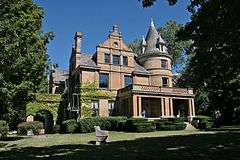George B. Cox


George Barnsedale Cox (1853–1916) was a political boss in Cincinnati, Ohio, United States, a member of the Republican Party, and associate of William Howard Taft.
Early life
Cox was the son of British immigrants. As a teen during the Civil War years, he supported his widowed mother as an errand boy. Later he drove a delivery wagon. Finally, he assisted his brother-in-law by operating the keno portion of the latter's casino. In these days he was already noted for being a physically strong and closed-mouthed man.
As a young man, Cox acquired a saloon at the corner of Longworth and John, "Dead man's corner".
Political career
Cox was elected to the city council in 1879, serving two terms. He served most notably on the Decennial Equalization Board where he was able to fix the tax rate for prominent properties like the Shubert Theater, in which he became an investor. He also served significantly on the Board of Public Affairs in this turbulent era of the notorious Courthouse Riots.
Known as a ward boss who delivered his delegation as promised, he became the executive chairman of the local chapter of the Republican Party. He ran unsuccessfully for Hamilton County Clerk in 1884 and 1888, being the only candidate on his party's ticket to lose in the latter year.
This did not prevent his ongoing rise to local dominance. During his heyday, his chief lieutenants were Deputy County Treasurer Rud K. Hynicka and the President of the Board of the New Water works Commissioners, August Herrmann. Herrmann became President of the Cincinnati Reds from 1902 to 1927 and is known as the Father of the World Series. Charles Phelps Taft, the rich lawyer brother of future President and Chief Justice William Howard Taft, owned and edited The Cincinnati Times-Star, which strongly supported the Cox machine, to the progressive reformer's embarrassment. in 1905, Secretary of War Taft called Cox's machine a "local despotism" for the benefit of cronies and big corporations. While Taft refused to support the Hamilton County Republican slate, he supported the Republican Governor Myron Herrick. However, voters did not split their tickets, leading to a statewide Democratic victory.[1]
Later life
George Cox died after suffering a stroke in 1916.[2]
Legacy
The George B. Cox House at the corner of Brookline and Jefferson avenues was listed on the National Register of Historic Places on November 6, 1973. The Cox House has been converted into a branch of the Public Library of Cincinnati and Hamilton County.[3]
Cox was the namesake of the George B. Cox Memorial Theater downtown on Seventh Street. Built in 1920, it closed in 1954 and was demolished in 1976.[4]
Notes
- ↑ D. K. Goodwin, The Bully Pulpit (Simon & Schuster 2013) pp. 435-436
- ↑ Felix Winternitz & Sacha DeVroomen Bellman (2007). Insiders' Guide to Cincinnati. Globe Pequot. p. 34. Retrieved 2013-05-08.
- ↑ , Public Library of Cincinnati and Hamilton County, 2015. Accessed 2015-10-15.
- ↑ Singer, Allen J. (2005). Stepping Out in Cincinnati: Queen City Entertainment 1900-1960. Arcadia Publishing. p. 20. Retrieved 9 December 2013.
Sources
- Miller, Zane L. (1968). Boss Cox's Cincinnati: urban politics in the progressive era. Oxford University Press, LC #68-29722. Reprint: Ohio State University Press (2000)
- Boyden, H.P. "Cincinnati's Battle With the Boss System", New York Times, August 24, 1903
External links
- "Henry T. Hunt and civic reform in Cincinnati, 1903-1913" - Landon Warner's scholarly article published in Ohio State Archaeological and Historical Quarterly.